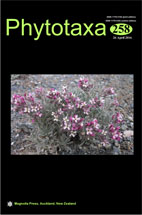Abstract
Neopestalotiopsis species are associated with a post harvest fruit rot and trunk disease of grapevines in China. A new species, N. vitis was isolated from the grape leaf spot in Guangxi Province, China. Initially, small circular, slightly sunken, necrotic spots, developed on the leaf surface, mainly at the inter-vein regions. The spots enlarged rapidly turning irregular, necrotic and brittle with age. Phylogenetic species recognition based on analysis of the combined ITS, TUB2 and tef1 sequence data coupled with morphology distinguished N. vitis from all other known species in the genus. This is the first report of a Neopestalotiopsis species causing a leaf spot on grapevine.

